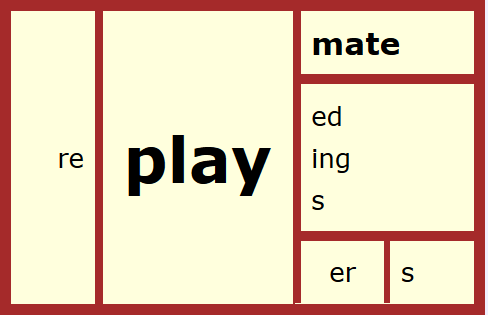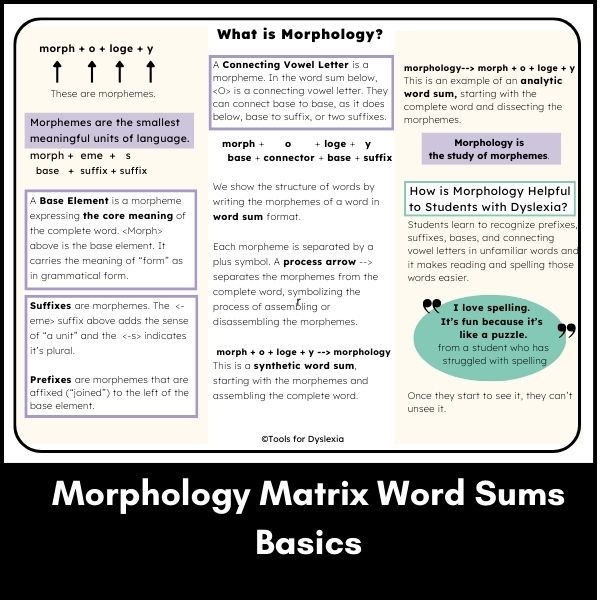Where to Start with Morphology
(This post contains affiliate links. Read my full disclosure.)

Before hearing about structured word inquiry (Bowers, 2010), word sums, and morphology about 10 years ago, the term “morphology” was not something I was familiar with. It took me a while to digest what morphology is and how to use it with students. Don’t miss the 3-page PDF at the end of the post with all the basics in one document.
Morphology is the study of the structure of words, a word’s meaningful parts.
Structural Elements of Morphology
The base element holds the core meaning of the word. A base might be a word on its own, which is a free base such as play. I can play Monopoly with you. It’s a free base because it doesn’t need a prefix or a suffix to be a complete word.
Some base elements need a prefix or a suffix or both to be a complete English word. This type of base is known as a bound base. It isn’t a complete English word without an affix (prefix/suffix). Spect is an example of a bound base. A bound base isn’t used as a word on its own. <Spect> is the base of these words: inspect, respectful, aspect, prospect, spectator, etc. Each example has either a prefix, a suffix, or both with the base <spect>.
A Brief Explanation of Angle Brackets & Slanted Brackets
These angle brackets < > indicate you’d spell out what’s inside the angle brackets. I’d say, s-p-e-c-t for the base in brackets. I’m not using slanted brackets / / but in case you run into them in other blog posts, they tell you I’m talking about the phonemes or pronounced sounds of a word. For example, if I were talking about the /k/ sound in spect, I would use slanted brackets.
Back to Structural Elements of Morphology
In the group of words with <spect> as its base, we see several prefixes: <in->, <-re>, <as->, and <pro->. In spectator, we see a couple of suffixes: <-ate> and <-or>. Whatever is inside the angle brackets is spelled out rather than said as a word—”the -a-t-e suffix” or “the -o-r suffix.” A prefix is one of the structural elements of morphology. Sometimes I might call a prefix, a suffix, or a base a word part. We can say that morphology is the study or noticing of meaningful word parts.
Something else new-to-me a decade ago was connecting vowel letters, sometimes called connectors. These vowel letters connect a base to a suffix or two bases or two suffixes. Connecting vowel letters are another affix, another meaningful word part.
Examples of connector between base and suffix:
- facial –> face + i + al
- usual –> use + u + al
- righteous –> right + e + ous
Examples of a connector between two bases:
- photograph –> phote + o + graph
- pedicure –> pede + i + cure
- chiropractor –> chir + o + pract + or
Examples of a Connector between two suffixes:
- editorial –> edit + or + i + al
- flirtatious –> flirt + ate + i + ous
Word Sums
The connecting vowel letter examples above are in word sum format. Word sums give students a multi-sensory opportunity to see and write and spell out the structure of words.
When we think of sums, we would first think of addition in math: this + that = something. But we never use an = equals sign in word sums. We use a process arrow to show that we’re joining things which may or may not be equal on both sides of the arrow. We never say equals either.
For example, race + ing –> racing. There is no <e> in the complete spelling on the right of the arrow. Also when we double a final consonant such as in tag + ed –> tagged. Because the parts are not equal to the whole, we don’t use an = equal sign.
There are two types of word sums: analytical and synthetic.
Analytical word sums begin with a complete English word on the left side of the arrow and the right side contains the morphemes, a base and some combination of affixes or bases. Some English words have only a base with suffixes.
Examples of analytical word sums:
- playfully –> play + ful + ly
- inspection –> in + spect + ion
Synthetic word sums begin on the left with the meaningful word parts (morphemes) and the complete word on the right side of the process arrow.
Examples of synthetic word sums:
- play + ful + ly –> playfully
- in + spect + ion –> inspection
One way to remember the difference in these two word sums is that with analytical word sums, you’re analyzing the complete word, taking it apart into its meaningful word parts.
Then synthetic word sums are synthesizing, putting the morphemes together, combining them into a complete word.

Word Matrix
One more tool that will change the way your students see words and think about reading and spelling is a word matrix. A matrix shows a family of interrelated words (Neil Ramsden, http://www.neilramsden.co.uk/spelling/matrix/index.html). You and your student(s) can write word sums using a matrix. Sometimes I ask students to read words from the matrix. They mentally put a base together with a suffix or suffixes, etc. and say the word.
Spelling Out
We’re using morphology, a matrix, and word sums to help our students see the morphemes to make reading and spelling words easier and to help them see the meaning tied to the spelling and structure of words. So we’re going to add another excellent tool to accomplish this. They will spell out the word sums. By saying spell out, I’m saying they will spell out loud.
inspection –> in + spect + ion would be spelled out “i-n plus s-p-e-c-t plus i-o-n becomes i-n-s-p-e-c-t-i-o-n, inspection.”
What does that do for our students? It attends their mind to the spelling and sequence of the word. Each grapheme, or letter is announced aloud by the student. Trust me when I tell you, it’s not easy at first for some of my students to do this, but it is valuable to be patient and support them with this tool. I might take turns doing this with them. With some students they might do one or two of these in a tutoring session because it’s so challenging for them to say the correct letters, in the correct order.
And that difficulty should tell us something. They have great difficulty paying attention and saying these letter names and even more difficulty getting them in order without skipping any.
Hmm. Had any students not pronounce all of a word’s sounds before? Yes you have. So have I. They need to notice every part of the word, not missing any of it. Morphology, word sums, matrices, and spelling out will help them improve in these areas.
Here’s a link to a word study with the <spect> word family.
Here’s the PDF I promised you. Morphology Matrix Word Sums Basics

Here are just a few resources available:
Books
I started with this one. Teaching How the Written Word Works by Dr. Peter Bowers is where many of us began learning about Structured Word Inquiry. Dr. Bowers coined the term, structured word inquiry (SWI), describing the format of discovering how English works with questions and investigations. He also offers classes (below).
Structured Word Inquiry, an Implementation Guide for Teachers by Jennifer Constantine & Kara Lee helps teachers, tutors, and parents see how to start using morphology, etymology, and phonology as they investigate words. Morphology plays a key role throughout structured word inquiry.
Dyslexia & Spelling Making Sense of It All by Dr. Kelli Sandman-Hurley explains why spelling is difficult for dyslexic students, provides simple explanations of where to start with morphology and etymology to teach spelling, and shares spelling activity ideas.
Beneath the Surface of Words by Sue Hegland has been described as a textbook for Structured Word Inquiry. It is thorough, masterfully written, and certainly one you’ll want to study as you become more comfortable with word study. I’m reading it now and it’s fine-tuning my understanding.
Classes
There are a number of individuals who offer courses in beginning Structured Word Inquiry. I’ll list a few. You can google more options.
Word Works Kingston, Dr. Peter Bowers
Empower Learning Center, Lisa Barnett
Structured Word Inquiry in the Classroom, Mary Beth Steven
Dyslexia Training Institute, Dr. Kelli Sandman-Hurley
Illuminated Words, Rebecca Loveless
Word Torque, Fiona Hamilton
Online Resources
Real Spelling Toolbox, an online subscription resource that provides a wealth of information about how English spelling works.
Etymonline.com is the go-to for understanding where a spelling came from, its history, and how it evolved to our Modern English spelling. This is a free website, but you can support it here. Here’s the introduction and explanation page that explains terms used in the site.
Mini-Matrix-Maker lets you create a matrix and Word-Searcher lets you search for specific spellings. Both are free. They’re created and managed by Neil Ramsden.
Check out all the lessons with word sums and a matrix, activities, word studies, and games here.
Follow the blog for more learning!

